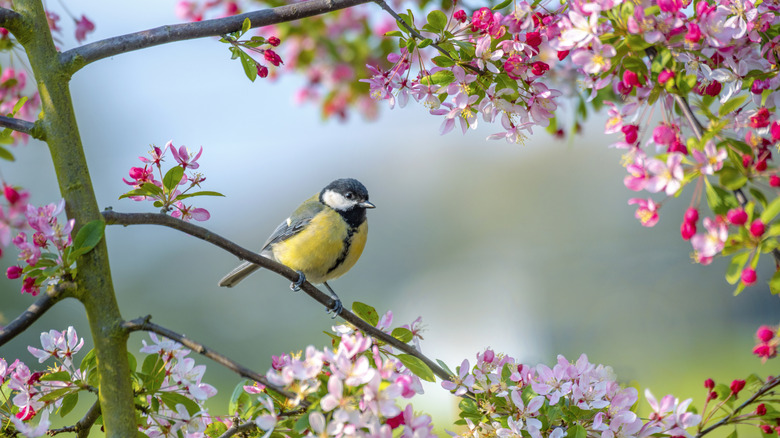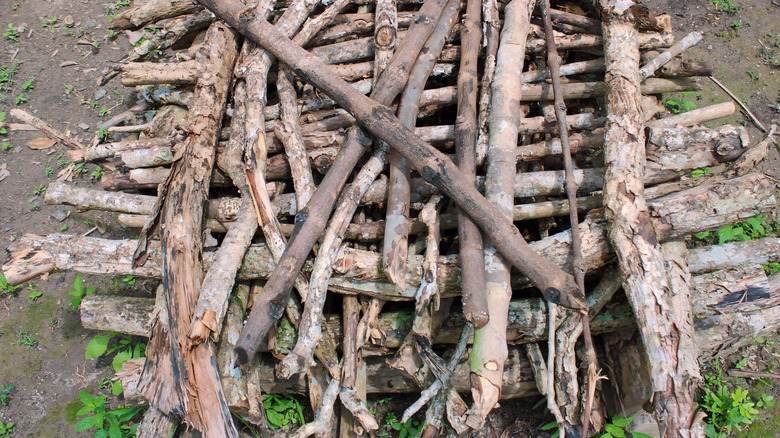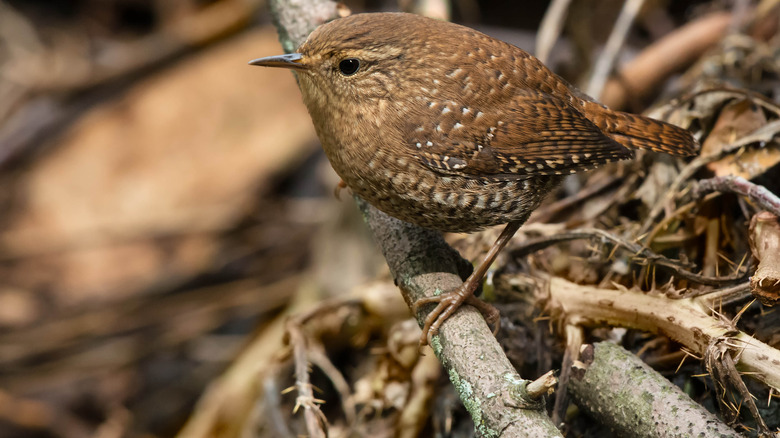The Winter Gardening Task That'll Prep Your Yard For Spring Birds
If you're looking forward to enjoying the cheerful chorus of different songbirds in your garden this spring, one of the best birdscaping tips to turn your yard into a bird haven also happens to be one of the easiest: don't throw away your yard debris. Instead, pile it at the back of your yard to build a habitat perimeter. Keeping a brush pile in your yard provides prime nesting ground for small birds and other wildlife. It's also important shelter for insects, which can be great for the garden and are an important food source for birds.
Creating this thriving wildlife habitat in your backyard is as simple as piling up any logs, fallen branches, pruned stems, and other natural yard debris in an unused corner or along the edge of your property. Come spring, birds will flock to the pile to forage for insects and use it as cover to hide from predators or keep warm on chilly nights. The simple task of piling up that debris instead of throwing it away can support a wide variety of life that benefit your garden in different ways — and it costs nothing to build. Whether your goal is to attract birds to your garden or provide more habitat for pollinators, a simple brush pile can do it. Just make sure to follow a few basic guidelines for where you place it and how you arrange the materials in the pile.
Tips for building a brush pile as wildlife habitat
There isn't any complex engineering involved in piling up brush somewhere in your yard, but following a couple of simple guidelines can increase the wildlife value. First, make sure to place it in an out-of-the-way location. The back corner of your yard, behind your garage, or behind a row of trees or shrubs are all great spots. The key is to choose a place far from your house where the pile won't be disturbed and is, ideally, out of eyesight.
After choosing a location, start piling. Woody materials like branches, logs, and stems are great, but you can also use rocks, old fence posts, leaves, and other debris to bulk up the pile. To construct it, start with your largest materials first, arranging them in alternating directions so there are plenty of crevices and gaps between pieces. Then, continue adding layers in the same way with your smaller materials, finishing with the smallest and least durable items like leaves and vegetation.
Ideally, your finished pile will be at least 6 feet tall and wide. If you don't have room in your yard for a pile of that size, it's ok to go smaller. In small yards, something as simple as placing a tree stump in the corner of your yard can still provide habitat for cavity-nesting bees and other insects that burrow into dead wood. Depending on the materials used, the brush pile should last up to 15 years with no added maintenance required beyond topping it off with fresh brush each year.
The benefits of building a habitat perimeter in your garden
While it might look like nothing more than a pile of sticks, the benefit of keeping a brush pile in your backyard is providing thriving ecosystem filled with insects, amphibians, birds, and other wildlife. The nooks and crannies between sticks provides overwintering sites and shelter for butterflies and fireflies. Meanwhile, ground-nesting bees can burrow into the soil underneath while cavity-dwelling bees burrow into the logs and branches.
The pile will also attract a variety of insects and organisms that eat the wood, slowly breaking the debris down into nutrient-rich organic matter that you can add to your soil to feed your plants. For small mammals, amphibians, and birds, the brush pile is the perfect place to take shelter from predators or build burrows. They can stay warm and snack on the insects living in the pile.
As a gardener, creating this kind of wildlife habitat has tons of benefits. For one, you'll attract songbirds, butterflies, and other beneficial critters that help pollinate your plants and control pest populations. The ability to listen to birds singing and watch butterflies and bees visit your flowers also makes your garden feel more lively and enjoyable. Above all, it doesn't require any extra work on your part. As you clear your yard of debris, just toss it on top of the brush pile to keep a continuous supply of fresh material as the older material on the bottom breaks down.


